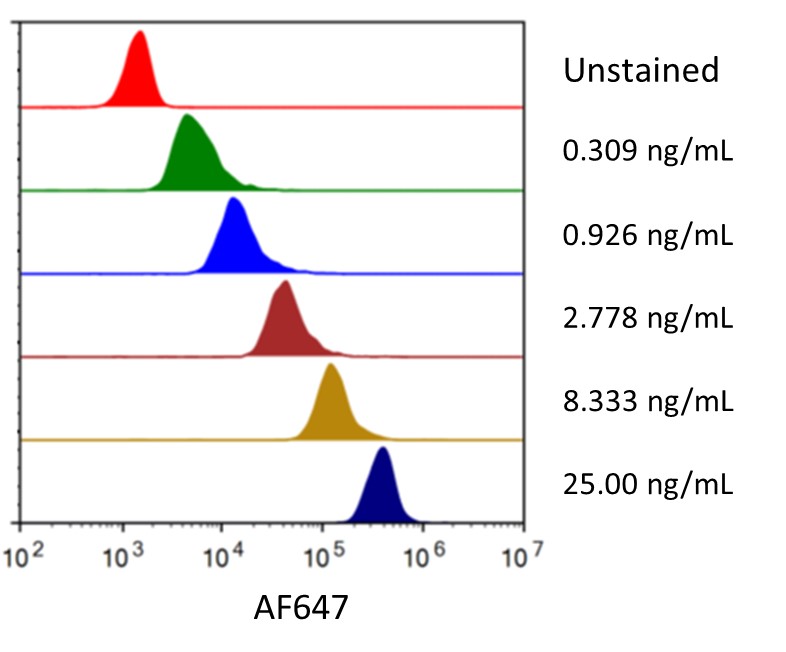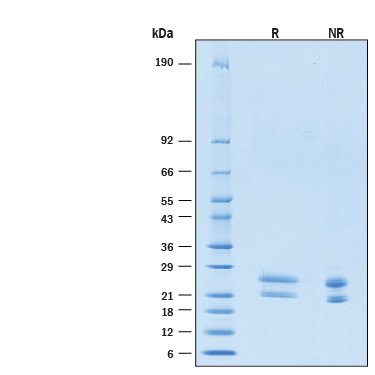Recombinant Human GITR Ligand Alexa Fluor® 647 Protein
Recombinant Human GITR Ligand Alexa Fluor® 647 Protein Summary
Learn more about FluorokinesTM Fluorescent-Labeled ProteinsProduct Specifications
| HA (YPYDVPDYA) | GCN4-IZ | Human GITR Ligand (Glu52-Ser177) Accession # Q9UNG2.3 |
| N-terminus | C-terminus | |
Analysis
Product Datasheets
AFR6987
| Formulation | Supplied as a 0.2 μm filtered solution in PBS with BSA as a carrier protein. |
| Shipping | The product is shipped with dry ice or equivalent. Upon receipt, store it immediately at the temperature recommended below. |
| Stability & Storage: | Protect from light. Use a manual defrost freezer and avoid repeated freeze-thaw cycles.
|
Scientific Data
 View Larger
View Larger
Streptavidin coated beads conjugated to biotinylated Anti Human GITRL (BAM6943) were stained with the indicated concentrations of Recombinant Human GITRL HA-tag Alexa Fluor® 488 (Catalog # AFR6987).
 View Larger
View Larger
2 μg/lane of Recombinant Human GITR Ligand/TNFSF18 (GCN4-IZ) Alexa Fluor® 647 Protein (Catalog # AFR6987) was resolved with SDS-PAGE under reducing (R) and non-reducing (NR) conditions and visualized by Coomassie® Blue staining, showing bands at 20-27 kDa.
Reconstitution Calculator
Background: GITR Ligand/TNFSF18
GITR Ligand, also known as TNFSF18 and TL6, is an approximately 30 kDa type II transmembrane glycoprotein in the TNF superfamily (1). Human GITR Ligand consists of a 50 amino acid (aa) cytoplasmic domain, a 21 aa transmembrane segment, and a 128 aa extracellular domain (ECD) (2, 3). Within the ECD, human GITR Ligand shares 56% and 60% aa sequence identity with mouse and rat GITR Ligand, respectively. GITR Ligand is expressed on antigen presenting cells,
CD4-CD8- double negative thymic precursors, vascular endothelial cells, neurons, and in the eye (4-11). Its expression is transiently up‑regulated by proinflammatory stimulation (4, 8, 11). The binding of GITR Ligand to GITR on mouse CD25+ Treg cells permits the reactivation of T cells from Treg-induced suppression, although this does not appear to occur in humans (5, 9, 12-14). GITR Ligand binding to GITR additionally provides a co‑stimulatory signal to activated CD4+ and CD8+ T cells and NK cells (5, 6, 15, 16). This interaction also induces reverse signaling in GITR Ligand expressing dendritic cells to suppress cellular activation through the same pathway induced by the immunosuppressant dexamethasone (17). In the brain, GITR Ligand/GITR interactions enhance NGF-mediated neurite outgrowth from sympathetic neurons (10).
- Azuma, M. (2010) Crit. Rev. Immunol. 30:547.
- Kwon, B. et al. (1999) J. Biol. Chem. 274:6056.
- Gurney, A.L. et al. (1999) Curr. Biol. 9:215.
- Stephens, G.L. et al. (2004) J. Immunol. 173:5008.
- Tone, M. et al. (2003) Proc. Natl. Acad. Sci. 100:15059.
- Hanabuchi, S. et al. (2006) Blood 107:3617.
- Kamimura, Y. et al. (2009) J. Immunol. 182:2708.
- Hwang, H. et al. (2010) J. Neurosci. Res. 88:2188.
- Tuyaerts, S. et al. (2007) J. Leukoc. Biol. 82:93.
- O’Keefe, G.W. et al. (2008) Nat. Neurosci. 11:135.
- Kim, B.J. et al. (2004) Invest. Ophthalmol. Vis. Sci. 45:3170.
- Shimizu, J. et al. (2002) Nat. Immunol. 3:135.
- Ji, H. et al. (2004) J. Immunol. 172:5823.
- McHugh, R.S. et al. (2002) Immunity 16:311.
- Kanamaru, F. et al. (2004) J. Immunol. 172:7306.
- Ronchetti, S. et al. (2004) Eur. J. Immunol. 34:613.
- Grohmann, U. et al. (2007) Nat. Med. 13:579.
Product Specific Notices
This product is provided under an agreement between Life Technologies Corporation and R&D Systems, Inc, and the manufacture, use, sale or import of this product is subject to one or more US patents and corresponding non-US equivalents, owned by Life Technologies Corporation and its affiliates. The purchase of this product conveys to the buyer the non-transferable right to use the purchased amount of the product and components of the product only in research conducted by the buyer (whether the buyer is an academic or for-profit entity). The sale of this product is expressly conditioned on the buyer not using the product or its components (1) in manufacturing; (2) to provide a service, information, or data to an unaffiliated third party for payment; (3) for therapeutic, diagnostic or prophylactic purposes; (4) to resell, sell, or otherwise transfer this product or its components to any third party, or for any other commercial purpose. Life Technologies Corporation will not assert a claim against the buyer of the infringement of the above patents based on the manufacture, use or sale of a commercial product developed in research by the buyer in which this product or its components was employed, provided that neither this product nor any of its components was used in the manufacture of such product. For information on purchasing a license to this product for purposes other than research, contact Life Technologies Corporation, Cell Analysis Business Unit, Business Development, 29851 Willow Creek Road, Eugene, OR 97402, Tel: (541) 465-8300. Fax: (541) 335-0354.This product is provided under an agreement between Life Technologies Corporation and R&D Systems, Inc, and the manufacture, use, sale or import of this product is subject to one or more US patents and corresponding non-US equivalents, owned by Life Technologies Corporation and its affiliates. The purchase of this product conveys to the buyer the non-transferable right to use the purchased amount of the product and components of the product only in research conducted by the buyer (whether the buyer is an academic or for-profit entity). The sale of this product is expressly conditioned on the buyer not using the product or its components (1) in manufacturing; (2) to provide a service, information, or data to an unaffiliated third party for payment; (3) for therapeutic, diagnostic or prophylactic purposes; (4) to resell, sell, or otherwise transfer this product or its components to any third party, or for any other commercial purpose. Life Technologies Corporation will not assert a claim against the buyer of the infringement of the above patents based on the manufacture, use or sale of a commercial product developed in research by the buyer in which this product or its components was employed, provided that neither this product nor any of its components was used in the manufacture of such product. For information on purchasing a license to this product for purposes other than research, contact Life Technologies Corporation, Cell Analysis Business Unit, Business Development, 29851 Willow Creek Road, Eugene, OR 97402, Tel: (541) 465-8300. Fax: (541) 335-0354.
FAQs
No product specific FAQs exist for this product, however you may
View all Proteins and Enzyme FAQsReviews for Recombinant Human GITR Ligand Alexa Fluor® 647 Protein
There are currently no reviews for this product. Be the first to review Recombinant Human GITR Ligand Alexa Fluor® 647 Protein and earn rewards!
Have you used Recombinant Human GITR Ligand Alexa Fluor® 647 Protein?
Submit a review and receive an Amazon gift card.
$25/€18/£15/$25CAN/¥75 Yuan/¥2500 Yen for a review with an image
$10/€7/£6/$10 CAD/¥70 Yuan/¥1110 Yen for a review without an image

